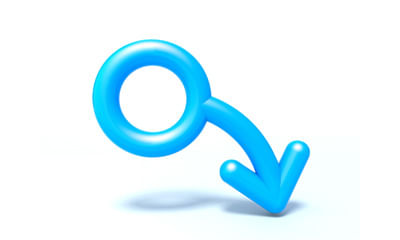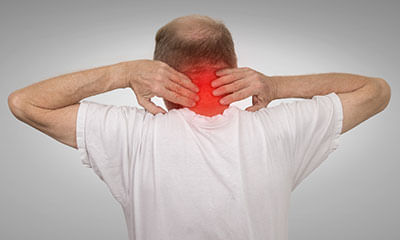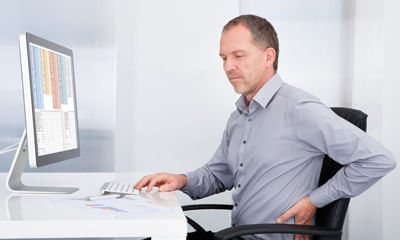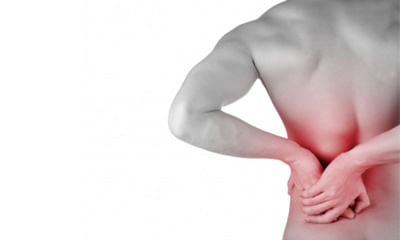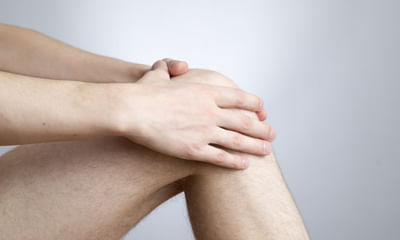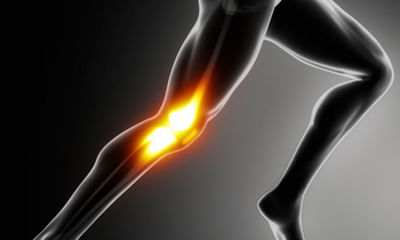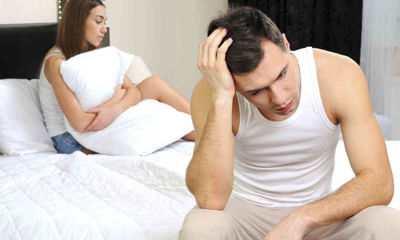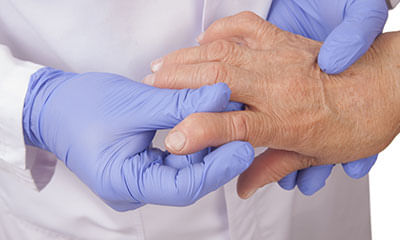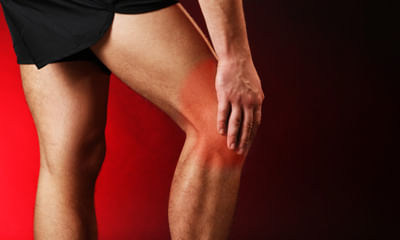Nerve Pain Treatments
Penile nerve injury resulting in incomplete erection and reduced pleasure with pain. ...
Ask Free Question
Follow these herbal combination for complete cure vrihad kamchoonamani ras 1 tablet twice a day kamdev avleh 10 gms twice a day.
Dear sir / madammy son (22) has been diagnosed with ankylosing spondylitis its early diagnosis. His hlab27 is positive. ...
Ask Free Question
Ankylosing spondylitis ankylosing spondylitis is a cause of back pain in adolescents and young adults. Ankylosing spondylitis is a form of chronic inflammation of the spine and the sacroiliac joints chronic inflammation in these areas causes pain and stiffness in and around the spine, including the neck, middle back, lower back, and buttocks. Over time, chronic inflammation of the spine (spondylitis) can lead to a complete cementing together (fusion) of the vertebrae, a process referred to as ankylosis. Ankylosis causes loss of mobility of the spine. Pt treatment deep breathing for lung expansion and stretching exercises to improve spine and joint mobility. Are also advised to sleep on a firm mattress and avoid the use of a pillow in order to prevent spine curvature. Aerobic exercise is generally encouraged as it promotes full expansion of the breathing muscles and opens the airways of the lungs. Home remedies physical therapy for ankylosing spondylitis includes instructions and exercises to maintain proper posture. This includes deep breathing for lung expansion and stretching exercises to improve spine and joint mobility. Since ankylosis of the spine tends to cause forward curvature (kyphosis), patients are instructed to maintain erect posture as much as possible and to perform back-extension exercises. Patients are also advised to sleep on a firm mattress and avoid the use of a pillow in order to prevent spine curvature. Ankylosing spondylitis can involve the areas where the ribs attach to the upper spine as well as the vertebral joints, thus limiting breathing capacity. Patients are instructed to maximally expand their chest frequently throughout each day to minimize this limitation. Physical therapists customize exercise programs for each individual. Swimming often can be a very beneficial form of exercise, as it avoids jarring impact of the spine. Ankylosing spondylitis need not limit an individual's involvement in athletics. People can participate in carefully chosen aerobic sports when their disease is inactive. Aerobic exercise is generally encouraged as it promotes full expansion of the breathing muscles and opens the airways of the lungs. Cigarette smoking is strongly discouraged in people with ankylosing spondylitis, as it can accelerate lung scarring and seriously aggravate breathing difficulties. Occasionally, those with severe lung disease related to ankylosing spondylitis may require oxygen supplementation and medications to improve breathing. People with ankylosing spondylitis may need to modify their activities of daily living and adjust features of the workplace. For example, workers can adjust chairs and desks for proper postures. Drivers can use wide rearview mirrors and prism glasses to compensate for the limited motion in the spine. You should check with your doctor before using compression socks for your swelling. These special socks should be properly fitted for you and your needs. Also, be sure to wear them during the day and remove them before you go to bed. Leg elevation if you stand a lot during the day, try propping your feet up or soaking them in water when you get home to help prevent swelling. Muscle relaxant: reduces muscle tension and helps relieve muscle pain and discomfort. Transcutaneous electrical nerve stimulation (also known as tens) is something which helps ease muscle pain and spasms. You can strengthen the muscles by doing tonificationie. Improving the tone of the muscles by adding either weight cuffs / sand bags which will help you to improve the strength of the muscle.
Female age: 18 height: 5’7 weight: 65-67 kg on 26 june 2022 I threw up blood for the first time (fresh blood and just co ...
Ask Free Question
Homeopathy has very effective and reliable treatment for your problem. No side effects. Please take homeopathic medicine, preliminary dose, ipecac 30-once daily in the evening for 3 days. Book online appointment/consultation with me -(commencing from text consult rs 149, audio/ phone-rs 300) for further more comprehensive prescription and treatment.
I have been suffering from disc herniation for the last 5 weeks. Pain is less than before. Rarely pain is observed in le ...
Ask Free Question
Poor sitting posture is a common cause of sciatica. To assist the support of your lower back many simple and effective products have been developed over time. These include: lumbar d-roll bassett frame kinesiology lumbar tape please ask your physiotherapist for their advice in what will help you most. This simple stretch helps relieve sciatica pain by loosening your gluteal and piriformis muscles, which can become inflamed and press against the sciatic nerve. 1.Lie on your back with your legs extended and your feet flexed upward. 2.Bend your right leg and clasp your hands around the knee. 3.Gently pull your right leg ac 4.Ross your body toward your left shoulder. Hold it there for 30 seconds. Remember to pull your knee only as far as it will comfortably go. You should feel a relieving stretch in your muscle, not pain. 5.Push your knee so your leg returns to its starting position. 6.Repeat for a total of 3 reps, and then switch legs. 5.sitting spinal stretch sciatica pain is triggered when vertebrae in the spine compress. This stretch helps create space in the spine to relieve pressure on the sciatic nerve. 1.Sit on the ground with your legs extended straight out with your feet flexed upward. 2.Bend your right knee and place your foot flat on the floor on the outside of your opposite knee. 3.Place your left elbow on the outside of your right knee to help you gently turn your body toward the right. 4.Hold for 30 seconds and repeat three times, then switch sides. 6. Standing hamstring stretch this stretch can help ease pain and tightness in the hamstring caused by sciatica. 1.Place your right foot on an elevated surface at or below your hip level. This could be a chair, ottoman, or step on a staircase. Flex your foot so your toes and leg are straight. If your knee tends to hyperextend, keep a slight bend in it. 2.Bend your body forward slightly toward your foot. The further you go, the deeper the stretch. Do not push so far that you feel pain. 3.Release the hip of your raised leg downward as opposed to lifting it up. If you need help easing your hip down, loop a yoga strap or long exercise band over your right thigh and under your left foot. 4.Hold for at least 30 seconds, and then repeat on the other sideif you have low back pain and sciatica you can undergo intermittent pelvic traction where in your half of your body weight will be added in the electronic traction so that that would help you to reduce the pain, along with interferential therapy stimulations which would help you to get relieved from the radiating pain. Apply ice for the pain to get subsided immediately. If you cannot go immediately for the physiotherapy treatment. Ice can be kept in the low back where you have back pain. It is suggestible to wear lumbo sacral belt which would help you to build the abdominal muscle tone which itself would make you feel better. You can also wear mcr chappals which would help you to have less weight falling in the painful back. U have to take vitamin d rich foods. Likemilk,cheese, yogurt,brocoli, spinach.u need calcium consumption for increase the bone density. Lackof bone and bones crush inside the body this might be due to low calcium or vitamin d which has more impact on the bone density and also it makes one to feel that there is lack of bone strength or in a way the bones are brittle and almost breaking and they feel it is crushed in a way there are many bones breaking at the same time. You have to take vitamin d rich foods. Likemilk,cheese, yogurt, brocoli, spinach.u need calcium consumption for increase the bone density. vitamin d intake via supplements or exposure to low levels of sunlight. Vitamin d is used to absorb calcium in the bone and regulate calcium in the blood. If you have leg pain then you have to rule out the causes for having leg pain. First of all check your weight and your haemoglobin levels, as anaemia always leads to the symptoms of being tired and also having leg pain though there are no issues with the knee joint or back pain. If not if the pain radiates down the back of thigh and legs then it might be due to sciatica. Kindly consult the nearby physiotherapist. Hope you recover soon from the leg pain. Lumbar radiculopathy: pain in lower back or glutei region with sharp shooting pain radiating from hip to leg/foot region, occurs in cases of lumbar radiculopathy or sciatica. This is due to compression of lumbar nerve root or sciatic nerve by disc prolapse, facet joint, trauma, hypertrophied ligamentumflavum, piriformis syndrome, etc. L5 vertrbrae and patient has pain the legs and sensation is disturbed? That is called as lumbar vertebrae. And there are 5 lumbar vertebrae and the 5th lumbar vertebrae is always is located in the lower end where the body weight is taken and it is generally fused with sacral vertebrae. That is where the sciatic nerve passes by and the nerve gets compressed that's the reason you have pain and sensation is disturbed. Loss of concavity of l4-l5 vertebrae. It is other wise called as the lumbo sacral curve which is very important for the spine to take the entire weight evenly if not it leads to disturbance of the disc and also the vertebrae which makes the spine to loose its concavity that's why it is called as loss of posterior concavity. For which we need to improve the spine posture and we need to adapt good posture during our day to day life activities. I have pain in my left side leg. This should be due to the sciatic nerve compression in the right side probably close to your l5 vertebrae. It can also be due to the strain on the left leg, try wearing mcr chappals which would help you to get relieved from pain. We suggest you to wear a lumbo sacral corset and also modified foot wear if you want we can send you by courier.
Sir, I have been suffering from disc herniation for the last 4 weeks .i'm unable to sit or stand for more than one hour. ...
Ask Free Question
If you had disc herniation 4 weeks back, by now your pain should be better and you should be doing back strengthening exercises. If not taken physiotherapy treatment then I would suggest to take proper therapy with Precaution and correct set of exercises. Pain radiating down the leg means nerve compression is there it should get better with the therapy ..only taking medicines will not help.
I am 35 years old I will not proper sleep and I have leg pain always in legs and sometimes cramp also. ...
Ask Free Question
Difficulty sleeping and leg pain, including cramps, can have various causes and may require different approaches for management. Here are some general suggestions that may help improve your sleep and alleviate leg pain: improve sleep hygiene: establish a regular sleep schedule by going to bed and waking up at the same time every day, even on weekends. Create a relaxing bedtime routine to signal to your body that it's time to wind down, which may include activities like reading, taking a warm bath, or practicing relaxation techniques such as deep breathing or meditation. Create a comfortable sleep environment: make sure your bedroom is conducive to sleep by keeping it dark, quiet, and cool. Invest in a comfortable mattress and pillows that support your body and promote proper alignment. Limit stimulants and electronics: avoid consuming caffeine or nicotine close to bedtime, as they can interfere with sleep. Additionally, limit exposure to electronic devices such as smartphones, tablets, and computers before bedtime, as the blue light emitted from these devices can disrupt your sleep-wake cycle. Manage stress: stress and anxiety can contribute to difficulty sleeping and exacerbate leg pain. Practice stress-reduction techniques such as mindfulness meditation, progressive muscle relaxation, or yoga to help calm your mind and relax your body before bedtime. Address leg pain and cramps: if you're experiencing frequent leg pain and cramps, it's essential to identify and address the underlying cause. Common causes of leg pain and cramps include muscle fatigue, dehydration, electrolyte imbalances, nerve compression, and certain medical conditions such as restless legs syndrome or peripheral artery disease. Consult with a healthcare professional to determine the cause of your leg pain and cramps and develop an appropriate treatment plan. Stay hydrated: drink an adequate amount of water throughout the day to prevent dehydration, which can contribute to muscle cramps. However, avoid consuming large amounts of fluids close to bedtime to minimize the need to wake up to urinate during the night. Stretch and exercise: gentle stretching exercises and regular physical activity, such as walking or swimming, can help improve circulation, reduce muscle tension, and alleviate leg pain. However, avoid vigorous exercise close to bedtime, as it may interfere with your ability to fall asleep.
My mother is 56 years old. She has been suffering with knee joints pain from last 9 years. Doctor says for knee replacem ...
Ask Free Question
Diabetes and knee replacement: diabetes can increase the risk of complications during surgery, including knee replacement surgery. However, many people with well-controlled diabetes can undergo knee replacement surgery safely. It's essential for your mother to discuss her diabetes management with her healthcare provider and the orthopedic surgeon who will perform the knee replacement. They will assess her overall health and determine if she is a suitable candidate for surgery. Close monitoring of blood sugar levels before and after surgery will be important to minimize the risk of complications. Numbness in feet: numbness and tingling in the feet can be symptoms of diabetic neuropathy, a common complication of diabetes that affects the nerves. It's important for your mother to have a thorough evaluation by a healthcare provider to assess her symptoms and determine the underlying cause. Additional tests, such as nerve conduction studies or electromyography (emg), may be recommended to evaluate nerve function. Shoulder, arms, and legs pain: pain in the shoulders, arms, and legs can have various causes, including arthritis, nerve compression, muscle strain, or other musculoskeletal conditions. Your mother may benefit from a comprehensive evaluation by a healthcare provider, possibly including imaging studies such as x-rays or mri, to determine the cause of her pain and develop an appropriate treatment plan. Comprehensive check-up: to address your mother's multiple symptoms and concerns, it's important for her to undergo a comprehensive medical evaluation. This may include: blood tests: to assess blood sugar levels, kidney function, lipid levels, and other metabolic parameters. Nerve function tests: to evaluate for diabetic neuropathy or other nerve-related issues. Imaging studies: such as x-rays, mri, or ultrasound to assess the condition of the knee joints, shoulders, and other affected areas. Consultations with specialists: such as an orthopedic surgeon, endocrinologist (for diabetes management), or neurologist (for nerve-related issues). Holistic approach: given your mother's multiple symptoms and medical conditions, a holistic approach to her care may be beneficial. This could include optimizing diabetes management, incorporating physical therapy or exercise programs to improve mobility and strength, and exploring options for pain management and symptom relief.
Why my penis inside trembling without any damage no pain just feeling vibrations. ...
Ask Free Question
Hello- if you have a history of masturbation then these signs denotes near muscular penile damage that is a side effects of masturbation. Fortunately, it is curable.
I have no mobility in my thumbs. I don’t know if it’s carpal tunnel or badal thumb arthritis? I need a diagnosis and x-r ...
Ask Free Question
It sounds like you're experiencing limited mobility in your thumbs and are unsure about the underlying cause, whether it's related to carpal tunnel syndrome or basal thumb arthritis. Here's what you can consider in terms of diagnosis and testing: medical evaluation: schedule an appointment with a healthcare professional, preferably a hand specialist or orthopedic surgeon, who can assess your symptoms and perform a thorough physical examination of your thumbs and hands. They will ask about your medical history, including any previous injuries or conditions that may be contributing to your symptoms. Diagnostic tests: based on your symptoms and physical examination, your healthcare provider may recommend one or more diagnostic tests to further evaluate your condition. These tests may include: x-rays: x-rays can help identify any abnormalities or degenerative changes in the bones of the thumb joint, which can indicate basal thumb arthritis. Blood tests: blood tests may be ordered to rule out underlying conditions such as rheumatoid arthritis or other inflammatory disorders that can affect the joints. Nerve conduction studies: nerve conduction studies can help assess nerve function and determine if there is any evidence of nerve compression or damage, which is characteristic of carpal tunnel syndrome. Electromyography (emg): emg testing may be recommended to evaluate the electrical activity of muscles and detect any abnormalities associated with nerve compression or damage. Imaging studies: in addition to x-rays, other imaging studies such as ultrasound or mri may be ordered to provide detailed images of the soft tissues, including the ligaments, tendons, and cartilage, to help assess the extent of joint damage or inflammation. Physical examination: your healthcare provider will also perform a physical examination of your thumbs and hands, assessing for signs of inflammation, swelling, tenderness, and range of motion. They may also perform specific tests to assess thumb function and mobility. Comprehensive assessment: based on the results of these tests and examinations, your healthcare provider can provide a comprehensive assessment and diagnosis of your condition. They will discuss treatment options tailored to your specific needs, which may include conservative measures such as splinting, physical therapy, or medications for pain and inflammation, as well as surgical options if necessary.
Sir I am 27 year old male I have symptoms of left shoulder and wrist pain while walking so I went to doctor doctor do fo ...
Ask Free Question
It looks like cervical pain that's the reason you have pain in the shoulder and along side until wrist. You need to take rest and you need to consult physiotherapist you need to do intermittent cervical traction and also inferential therapy treatment which will help you to get subsided with pain. Neck pain cervical spondylosis– chronic condition with radiating pain this is cervical pain (neck pain) and that's the reason the pain radiates until the shoulder blades. If you keep ice that would help and along side you can do hot water fermentation. You shall use cervical collar which would help you to reduce the radiating pain ie. Due to the nerve compression. You have to go for traction and also you can do ift. Please consult the near bytherapist for quick relief. Use collar will definitely be helpful for him to maintain the good posture. And also cervical pillow can be used which might make you to have better posture of the shoulder neck and arm. Neck tilt: from the sitting position, tilt your head down so your chin touches your chest. Hold this position for 5 second s. Return to the starting position and repeat. Do this five times. Side-to-side neck tilt. From the same starting position, tilt you neck toward one shoulder, leading with your ear. Hold for 5 seconds and then return to the starting position. Do this five times on each side. Neck turn. Look straight ahead, then turn your head to one side, keeping your chin at the same level. Do this five times on each side. Neck stretch. Holding the rest of your body straight, push your chin forward, stretching your throat. Hold for 5 seconds. From the same starting position, push your chin backward and hold for 5 seconds. Do the forward and backward stretch five times each. If any of these exercises cause severe pain or weakness in your hands or arms, stop right away and talk with your doctor. We suggest you to wear cervical collar which will help you to improve the cervical angle and also it definitely helps you to improve the neck posture due to which your neck pain is triggered more. The importance of wearing cervical collar is to give good stability to the neck and also it definitely prevents you to have excess neck movements which makes the condition worse. If you wear cervical collar you cannot turn your neck as you like which itself will help you to have better functioning of the cervical spine. This cervical soft collar what we are suggesting for you is available at our clinic. If you want you can buy from us, if you are far away from chennai we can send you by courier. The reason why we are conveying you to buy from us is we can demonstrate over the videocall (using whatsapp) and also we can monitor you throughout when to wear it and how long to wear it. And also if you find any difficulty wearing the brace you can also revert back to us for few more suggestions and we can propose you good solution how to go about it. Pushups this one may seem basic, but there’s no denying that pushups are one of the best ways to strengthen the pectoral muscles. These can be done on the knees or toes. If you’re not ready for full pushups, start with your hands resting on a solid surface higher than your feet — like a very sturdy coffee table or the edge of a couch, cushions removed, that’s pressed up against a wall — and start on the toes. Having your hands higher than your feet and your body at an angle can be a good way to start a pushup regimen. As you get stronger, you can begin to lower the angle of your body. This will help you transition to full pushups more easily than going from knees to toes. A full plank engages the muscles differently, even at an angle. When doing pushups, aim for 2 sets of 10 reps per day. 1.start in plank position with your hands under your shoulders and your core engaged. 2.as you lower, inhale. 3.as you engage your muscles to push yourself up, exhale. Keep your elbows hugging in close to your body. Keep your focus on slowly breathing as you do these, and on engaging the pectorals while keeping the core tight. Don’t just crank these out to get them done — this can compromise your form and do more harm than good. If the movement is really tough, break the sets into three or five to start, or find a higher point to begin after a week of exercise. If necessary, you can even stand and do pushups pushing against a wall. Chest fly for this exercise, you’ll need a bench or exercise ball as well as some dumbbells. If you don’t have weights, you can always use the old standby: a soup can in each hand. Just keep in mind that dumbbells are easier to hold and you can get more out of using them, as even 5-pound weights are heavier than your heaviest canned goods. 1.lie with your upper and middle back on a bench or ball, with your legs at a 90-degree angle. Hold a weight in each hand and extend your arms to the sky, elbows slightly bent. 2.as you inhale, lower your arms out wide, until your elbows are at shoulder height. 3.as you exhale, raise your hands until they meet above your chest again. 4.do 2 sets of 10. If that feels pretty easy, up it to 2 sets of 15 or increase the weight you’re using. Dumbbell row strengthening your back muscles is an important component of treating pectusexcavatum. The dumbbell row targets your lat muscles. The way it’s described below also strengthens your core, another important component of treating the condition. You’ll need some dumbbells to complete this move — err on the lighter side if you’ve never done a row before. 1.hold one dumbbell in each hand with your arms extended. Hinge at the hips until your upper body reaches a 45-degree angle. 2.keeping your neck in line with your spine and your gaze straight down, pull your elbows straight back and squeeze between your shoulder blades. 3.extend your arms back to the starting position. Complete 2 sets of 10. Dumbbell rear delt fly another move to strengthen your back, a dumbbell rear delt fly also focuses on the lats, as well as the rhomboids and the traps. Choose a light pair of dumbbells to complete this move and ensure that you’re pinching your shoulder blades together at the top to get the most out of it. 1.hold one dumbbell in each hand with your arms extended. Hinge at the hips until your upper body reaches a 45-degree angle and bring the dumbbells together. 2.keeping your spine and neck neutral, inhale and push the dumbbells out and up to the side until your arms are parallel to the floor. 3.exhale and return to the start in a slow and controlled motion. Complete 2 sets of 10. Exercise is a key component to treating pectusexcavatum. By strengthening your chest, back, and core muscles and stretching your chest cavity, you can combat the condition’s effects. Aim to complete these exercises several times a week to maximize results. Anterior pelvic tilt 1.lie on the back with the knees bent and feet flat on the floor, hip-width apart. 2.squeeze the buttocks and tilt the pelvis upward. 3.the back should feel as though it is flattening to the ground. 4.return to normal pelvis position. 5.repeat 10–12 times.

